
Home - Search - Browse - Alphabetic Index: 0- 1- 2- 3- 4- 5- 6- 7- 8- 9
A- B- C- D- E- F- G- H- I- J- K- L- M- N- O- P- Q- R- S- T- U- V- W- X- Y- Z
Gemini 8
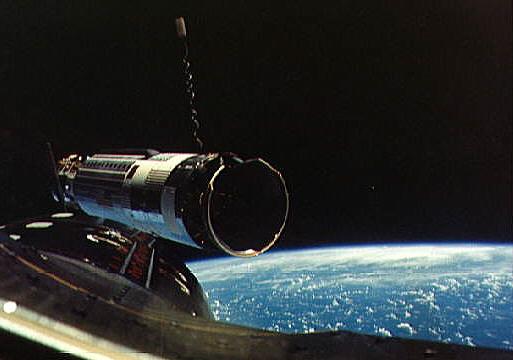
Agena in orbit
Credit: NASA
Launched: 1966-03-16. Returned: 1966-03-17. Number crew: 2 . Duration: 0.45 days. Location: Neil Armstrong Museum, Wapakoneta, OH.
The Atlas-Agena target vehicle for the Gemini VIII mission was successfully launched from KSC Launch Complex 14 at 10 a.m. EST March 16. The Gemini VIII spacecraft followed from Launch Complex 19 at 11:41 a.m., with command pilot Neil A. Armstrong and pilot David R. Scott aboard. The spacecraft and its target vehicle rendezvoused and docked, with docking confirmed 6 hours 33 minutes after the spacecraft was launched. This first successful docking with an Agena target vehicle was followed by a major space emergency. About 27 minutes later the spacecraft-Agena combination encountered unexpected roll and yaw motion. A stuck thruster on Gemini put the docked assembly into a wild high speed gyration. Near structural limits and blackout, Armstrong undocked, figuring the problem was in the Agena, which only made it worse. The problem arose again and when the yaw and roll rates became too high the crew shut the main Gemini reaction control system down and activated and used both rings of the reentry control system to reduce the spacecraft rates to zero. This used 75% of that system's fuel. Although the crew wanted to press on with the mission and Scott's planned space walk, ground control ordered an emergency splashdown in the western Pacific during the seventh revolution. The spacecraft landed at 10:23 p.m. EST March 16 and Armstrong and Scott were picked up by the destroyer U.S.S. Mason at 1:37 a.m. EST March 17. Although the flight was cut short by the incident, one of the primary objectives - rendezvous and docking (the first docking of two spacecraft in orbital flight) - was accomplished.
Primary objectives of the scheduled three-day mission were to rendezvous and dock with the Gemini Agena target vehicle (GATV) and to conduct extravehicular activities. Secondary objectives included rendezvous and docking during the fourth revolution, performing docked maneuvers using the GATV primary propulsion system, executing 10 experiments, conducting docking practice, performing a re-rendezvous, evaluating the auxiliary tape memory unit, demonstrating controlled reentry, and parking the GATV in a 220-nautical mile circular orbit. The GATV was inserted into a nominal 161-nautical mile circular orbit, the spacecraft into a nominal 86 by 147-nautical mile elliptical orbit. During the six hours following insertion, the spacecraft completed nine maneuvers to rendezvous with the GATV. Rendezvous phase ended at 5 hours 58 minutes ground elapsed time, with the spacecraft 150 feet from the GATV and no relative motion between the two vehicles. Stationkeeping maneuvers preceded docking, which was accomplished at 6 hours 33 minutes ground elapsed time. A major problem developed 27 minutes after docking, when a spacecraft orbit attitude and maneuver system (OAMS) thruster malfunctioned. The crew undocked from the GATV and managed to bring the spacecraft under control by deactivating the OAMS and using the reentry control system (RCS) to reduce the spacecraft's rapid rotation. Premature use of the RCS, however, required the mission to be terminated early. The retrofire sequence was initiated in the seventh revolution, followed by nominal reentry and landing in a secondary recovery area in the western Pacific Ocean. The spacecraft touched down less than 10 km from the planned landing point. The recovery ship, the destroyer Leonard Mason, picked up both crew and spacecraft some three hours later. Early termination of the mission precluded achieving all mission objectives, but one primary objective - rendezvous and docking - was accomplished. Several secondary objectives were also achieved: rendezvous and docking during the fourth revolution, evaluating the auxiliary tape memory unit, demonstrating controlled reentry, and parking the GATV. Two experiments were partially performed.
Official NASA Account of the Mission from On the Shoulders of Titans: A History of Project Gemini, by Barton C. Hacker and Charles C. Alexander, Published as NASA Special Publication-4203 in the NASA History Series, 1977.
On 16 March 1966, five months after Walter Schirra and Thomas Stafford had been left at the starting gate in NASA's first attempt to launch two vehicles toward rendezvous on the same day, NASA tried again. This time nothing marred the countdown of the Atlas-Agena or the Gemini space vehicle.
The target launch vehicle lifted from pad 14 at 10 o'clock in the morning. Its trajectory was at first low and to the right (south) of the intended flightpath. The sustainer engine rammed the target back on track. In a little more than five minutes, the Atlas had done its job. Now it was Agena's turn. After a short coast, its secondary propulsion system burst into life. The crucial test for the Agena came with the firing of its main engine, and the engineers crossed their fingers and held their breaths. But it worked. The engine ignited and carried the target into a 298-kilometer circular orbit. Planners had wondered if the Agena could so position itself that astronauts could catch it. The answer was yes!
With one up and one to go, attention turned to 19. Fourteen minutes before the Atlas-Agena lifted, Armstrong and Scott slid through the spacecraft hatches into their couches. As the flight-preparation crew helped harness Scott to his parachute, they found one of its catches full of glue. Backup command pilot Conrad and McDonnell pad leader Guenter Wendt began digging it out. Just a little thing like that, Scott thought, "might have cost us a launch," but he could not help smiling as he watched Conrad sweat over the job. The catch came unglued and Gordon, the backup pilot, tried the fitting a few times to prove to Scott that it was working. Learning of the Agena's nearly perfect orbit, Armstrong said, "Beautiful, we will take that one."47
Given the Agena's orbital parameters, the Gemini launch vehicle should lift off at 10:40:59 am. The powerful engines of Titan II throbbed into life exactly on time, and Armstrong and Scott felt the hold-down bolts shear for breakaway. GLV-8 started off a little low, as bad Atlas, but soon straightened to boost the 3,788-kilogram (8,351-pound) spacecraft into an elliptical orbit 160 by 272 kilometers.
After the first hurdle had been vaulted, the next challenge was catching the target. Procedures were much the same as those for Gemini VI-A, although this time there was no friendly target to point its attached transponders toward the spacecraft's radar. Armstrong and Scott began the chase 1963 kilometers behind the Agena.
Thirty-four minutes into the flight, the Sun set and, in the engulfing darkness, the crew could see brilliant fires streaming from their spacecraft's thrusters. As the radiator in the adapter expelled water, the thrusters fired to compensate for a sideward turn. The Carnarvon, Australia, tracking station told them the radiator was not much of a problem and passed to them the Flight Director's "go" for a day's flight.
Over the Pacific, the two astronauts had some time to sightsee. Molokai, Maui, and Hawaii hove clearly into view. Armstrong tried to see Karnai and Oahu, but cloud banks obscured them. Minutes later, Scott said to his partner, "We're going over Baja California now. Can you been it?" But Armstrong had his eyes on the Los Angeles ship basin in the other direction, and his response was, "Oh, look at all those ships!" Armstrong then spotted the Rogers Dry Lake bed. He looked for, but was not certain he found, Edwards Air Force Base, where he had spent seven years piloting experimental airplanes. Over Texas, both men wanted to see if they could spot their homes, but work preempted this scenic interlude. At the low point of their first circuit of Earth, Armstrong aligned the inertial platform for a height adjustment maneuver. At 1:34 hours elapsed time, he touched off a five-second burst of the thrusters for a small retrograde change in velocity, to lower the apogee slightly. Armstrong noticed a problem in cutting off residual thrust. This resulted in varying computer readings and made it difficult to tell the exact deceleration obtained.
On their mission, Schirra and Stafford had been so preoccupied that they had not taken time to eat, which left them hungry, as well as tired, when they caught up to Borman and Lovell. Scott and Armstrong knew they would be very busy all three days of their mission, so each grabbed a package of food and started preparing a meal, which seemed to take longer than they thought it would. When they had to stop and align the platform for a maneuver to raise the perigee, they placed the food packages against the spacecraft ceiling. Weightlessness was handy.
Nearing second apogee (2:18:25 hours), Armstrong fired the thrusters to add 15 meters per second to their speed. Again, tail-off residuals made it hard to get a computer reading. After this maneuver, Armstrong and Scott pulled their food from the ceiling. Although Armstrong's chicken and gravy casserole had been mixed with water for half an hour, it was still dry in spots and not much like home cooking. But he finished it and washed it down with fruit juice to keep from dehydrating. Then he tried a package of brownies, which were stuck together and crumbly. They were hard to eat without scattering weightless scraps all over the cabin.
The next maneuver was designed to push the spacecraft into the target's orbital plane. Armstrong yawed Gemini VIII's nose 90 degrees south of the flight path. Over the Pacific Ocean, 25 minutes before completing the second revolution (2:45:50 hours), the command pilot punched the aft thrusters to produce a horizontal velocity change of 8 meters per second. He waited for the ground controllers to tell him if any adjustment was needed. Hearing nothing, he assumed his thrusting had been correct. Over the Guaymas, Mexico, tracking station, Lovell, the Houston CapCom, suddenly cut in on the remote site line to order him to add 0.6 meter per second to his speed. With only a minute to get ready, there was little time to turn the spacecraft and no time to align the platform. "It was a pretty quick loose burn ... without much preparation," Scott said.
Armstrong and Scott then began the rendezvous radar test. They did not expect to get radar contact as quickly as Schirra and Stafford had, but the Westinghouse development team had promised target acquisition at 343 kilometers. The radar locked on solidly at 332 kilometers, which was good enough.
Over the Tananarive tracking station, 3:48:10 hours after launch. Armstrong nosed the spacecraft down 20 degrees and applied the aft thrusters for an in-plane (with the target) velocity change of 18 meters per second. This gave them a nearly circular orbit close to 28 kilometers below that or the target. The spacecraft was now in position to start the terminal phase of rendezvous.
The crew sighted a shining object 140 kilometers ahead, which must be the Agena. After closing to a range of 102 kilometers, all doubts were erased - the target gleamed in the sunlight. Scott switched the computer from the catchup to the rendezvous mode and watched the distance dwindle on the slide, automatically. Just before sunset, the Agena suddenly disappeared, but at twilight its acquisition lights blinked into view.
When the Agena was at the proper angle (10 degrees) above them, Armstrong aligned the inertial platform for the translation maneuver. Then he pitched Gemini VIII's nose up 31.3 degrees and canted the vehicle 16.8 degrees to the left. At 5:14:56 hours, ground elapsed time, the command pilot fired his aft thrusters, later making two small corrections. High over the Coastal Sentry Quebec tracking ship, stationed near Antigua Island, at 5:43:09 hours, he braked the spacecraft. Since he could see the Agena, Armstrong judged his braking action by eye as Scott called out radar range and range rate. At a distance of 46 meters, relative velocity between the two vehicles had been canceled. The second rendezvous in the Gemini program had been achieved.
For 36 minutes after rendezvous, Armstrong's delicate maneuvering kept his spacecraft on station with the target vehicle. As the command pilot drove, Scott inspected the Agena - checking antennas, docking lights, and the like. Finding it hard to see all of the target's instrument panel displays near the docking cone, he used the telescopic sight of a hand-held sextant. But a really good look would have to wait until they were docked, when these instruments would become a second dashboard. Meanwhile, Armstrong studied the general appearance of the Agena. It seemed stable, and he nudged the spacecraft to within a meter (about three feet) of the target. Then, at 6:32:42, Keith K. Kundel, CapCom on the Rose Knot Victor, radioed, "Go ahead and dock."
Armstrong eased Gemini VIII toward the target at a barely perceptible rate of 8 centimeters (3 inches) per second. "About two feet (60 centimeters) out," he told the Rose Knot Victor. In a matter of seconds, Armstrong gleefully reported, "Flight, we are docked! It's . . . really a smoothie - no noticeable oscillations at all." For a moment, the flight controllers in Houston could not realize that they had really done It. Then pandemonium broke loose, with back slaps, hand shakes, cheers, and tremendous grins.
Because there had been some difficulty in verifying the Agena's uplinked stored program commands for the planned docked yaw maneuver and in loading the target's velocity meter, the flight controllers suspected that Agena's attitude control system might be misbehaving. In fact, Lovell, on the remote link through Tanarive just before the spacecraft passed out of communications range, told the crew, "If you run into trouble and the attitude control system in the Agena goes wild, just . . . turn it off and take control with the spacecraft." With this warning raging in their ears, Armstrong and Scott began their docked chores.
The Agena was designed to obey orders from the spacecraft, as well as from ground control. Scott commanded the target's attitude control system to turn the vehicle combination 90 degrees to the right. It took five seconds less than the full minute expected. Scott next dialed an order to start the Agena's tape recorder and looked over toward Armstrong. As he did, his gaze skimmed the control panel in the spacecraft. Something had to be wrong - Gemini VIII should be in level flight, but the "ball" indicator showed a 30-degree roll. He knew there was no use checking the horizon out the window, as they were passing through Earth's shadow. There would be no help from the ground tracking stations either; they were still out of communications range.
"Neil, we're in a bank," Scott said. He thought perhaps his spacecraft attitude ball had tumbled, but Armstrong's indicator showed an identical mark. The command pilot managed, with bursts from the OAMS, to stop the motion temporarily, but it soon started again. Their immediate reaction was to blame the Agena. As soon as the vehicles were steady enough, Scott commanded the target to turn off its attitude control system, as the communicator had instructed. For four minutes, the two craft steadied and straightened up; the trouble seemed to be over. Armstrong started maneuvering to get the docked vehicles into the correct horizontal position; suddenly they began to roll again, faster and faster. "What's the problem now?" the pilots wondered. They were supposed to do a small test to find out what stress and strain the linkage between the two vehicles could tolerate. That issue was now academic; the immediate question was whether it could stand up under these wild gyrations.
While Armstrong struggled with the controls, Scott photographed the interaction between the two vehicles out of his spacecraft window. The command pilot soon reported that the OAMS propellant had dropped to 30 percent, a strong clue that a spacecraft thruster might be causing the trouble. While Armstrong fought the controls, Scott cycled the target vehicle switches off and on and off again. Then Armstrong jiggled the spacecraft switches as well, to see if they could isolate the problem. Nothing they did seemed to have any effect.
The crew realized that they would have to break away from the Agena to analyze the situation. Past simulation training gave them no clues to what was happening or how to handle it. Scott transferred control of the Agena to the ground stations (which had been locked out to prevent spurious signals), and Armstrong labored to steady the vehicles enough to divorce them. "Go," Armstrong said, and Scott hit the undocking button. Armstrong gave the thrusters a long hard burst, and the spacecraft pulled straight back.
Almost immediately, suspicion about a spacecraft control problem became an established fact as the spacecraft rolled even faster. "And then we really took off," Armstrong and Scott later reported. Gemini VIII soon came into acquisition range of the Coastal Sentry Quebec. James R. Fucci, CapCom aboard the ship, was concerned and perplexed. He could not get a solid electronic lock-on, but a blinking light signal indicated that the craft had undocked. Unaware that the spacecraft was rolling, so the antennas could not remain in position, he put in a call to the crew to try to find out about these strange signs he saw on his console.
Fucci: Gemini VIII, CSQ CapCom. Com check. How do you read?
Scott: We have serious problems here . . . we're tumbling end over end up here. We're disengaged from the Agena.
Fucci: Okay. We got your SPACECRAFT FREE indication here. . . . What seems to be the problem?
Armstrong: We're rolling up and we can't turn anything off. Continuously increasing in a left roll.
Fucci: Roger. (37 seconds later) Gemini VIII. CSQ.
Armstrong: Stand by.
Scott: We have a violent left roll here at the present time and we can't turn the RCS's off, and we can't fire it, and we certainly have a roll . . . stuck hand control.
After backing away from the Agena, the spacecraft had started to whirl at a dizzying rate of one revolution per second. Armstrong suspected that the maneuvering thrusters were about finished. He and Scott were also having trouble seeing the overhead panel dials; their physiological limits seemed near. They were dizzy, and their vision was blurred. Something had to be done. "All that we've got left is the reentry control system," Armstrong said. "Press on," Scott responded. The two men began to throw switches to cut out the OAMS and cut in the reentry control system. Armstrong tried his hand controller - nothing. Scott tried his - still nothing. They started switching circuitry again - maybe something had been set in the wrong position.
The hand controllers responded!
Armstrong steadied the motion and then turned off one ring of the reentry control system to conserve fuel. He then carefully reactivated the maneuver thrusters; now they were able to tell that No. 8 had "failed on" - that is, it had stuck open!
Using the reentry control thrusters meant that the Gemini VIII mission would have to come to an end as soon as possible. That was a mission rule. True, the spacecraft was operating in a backup mode - but it was the prime mode for reentry. If these thrusters developed leaks, the crew would have absolutely no means of getting the spacecraft into position for the critical retrofire that would return them to Earth. Attitude control before and after reentry was essential to reenter the atmosphere safely. Here was a case where the fail-safe maneuvers that Headquarters had insisted on early in the program were impossible - there was virtually no maneuverability left in the orbital thrusters. Armstrong and Scott also remembered, wistfully, that Kraft, the flight controllers, and engineers had nursed other missions to completion. Could the same be done for them now? This was but a fleeting hope, as the Hawaiian tracking station communicator told them to get their spacecraft into position for reentry.
Gemini VIII's problems were certainly the most frustrating of any Gemini had yet encountered. The flight control team's ability to respond to real problems on previous missions, keeping spacecraft flying to wring all useful data from failures as well as successes, had bolstered confidence in the program and promoted "real-time" planning. But Gemini VIII's failure had forced the astronauts to resort to a last-ditch mode for attitude control before the ground crews had a chance to provide the options that might have allowed the flight to go on.
John Hodge, in his first trial as chief flight director, now had only one choice left - which contingency recovery landing area would be best? If he waited much longer, it would take a full day (or 15 revolutions) for the crew to reach a splashdown point from which they could be quickly recovered. Since the orbital track had precessed westward, landing during the sixth or seventh orbits would have to take place in the Pacific Ocean. When the Landing and Recovery Division recommended a touchdown in the seventh circuit, Hodge agreed.
Kranz had dropped by to listen to the spacecraft and target docking. Since Hodge had been at the flight director's console for 11 hours, he and Kranz decided that the second shift should report for duty immediately, catch up on all information, and direct the final Phases of the mission. Had the flight continued for three days, reentry would have taken place on Kranz' shift, anyway, and he and his men had more practice in recovery procedures than Hodge and his group.
The engineers who had worked so hard on the Agena's problems found their situation just as exasperating as that of the flight controllers. After the docking, Smith, Harold W. Nolan, and others from Lockheed had retired to nearby motel rooms to celebrate the momentous event. Very shortly, Smith called Nolan, saying, "We‘ve got trouble!" Nolan switched on his television, only to hear newscasters reporting that the Agena was at fault. Smith's motel room became the initial Lockheed failure-analysis command post, the first guess being that the target's attitude control system had failed.
Many other engineers and program officials also heard about the spinning spacecraft while out of touch with minute-by-minute developments. Mueller, for instance, had remained at Cape Kennedy only through launch and the early phases of the mission. Then he took off for Washington to attend the annual Robert H. Goddard Memorial Dinner, sponsored by the National Space Club. The pilot of the NASA aircraft heard what was happening over the plane's radio and informed Mueller. They returned to Florida, where Merritt Preston met Mueller's party with a motorcycle escort, the prelude to a hair-raising ride to the old Mercury Control Center in time for spacecraft retrofire.
Most of NASA's leaders at Headquarters had, in fact, already headed for the Goddard dinner - the prestigious social event of the year for the space community. At the opening reception, Deputy Administrator Seamans was called to the telephone to learn of Gemini VIII's plight. He immediately phoned Houston Flight Control and learned that the spacecraft spinning had been stopped. When he told the chairman of the dinner about the trouble, Seamans was asked to make a brief announcement: he said the flight would have to be aborted, but the crew seemed in no immediate danger. Vice President Hubert H. Humphrey, the principal speaker, asked to be told as soon as the crew had been successfully recovered. Before he had finished his address, Humphrey was able to inform his listeners that Armstrong and Scott had landed safely. Seamans vowed that never again would he be caught in a public position during the critical phase of any succeeding flight. He needed privacy and better communications with the Control Center.
As a rule, McDonnell (the spacecraft contractor) sent several of its experts from the Cape to Houston after launch and first orbit to be available as troubleshooters. On 16 March 1966, a NASA Gulfstream left Florida for Texas with about 14 passengers, among them several high-ranking McDonnell engineers. Over New Orleans, the pilot cut in a commercial radio broadcast to the cabin. The announcer was talking about an imminent recovery in the Pacific. This was all the startled passengers beard, since the news announcement ended there. Something had obviously gone wrong, but what was it? There was nothing to do but wait until they got to Houston.
Raymond Hill, McDonnell's Gemini manager at the Cape, recalled that his company's policy changed radically after "I . . . was caught with my pants down." In the future, senior McDonnell officials - Hill, Walter Burke, John Yardley, and Robert Lindley - would not be in transit at the same time during a flight. Hill stayed at the Cape, Burke went to Houston for the first day of the flight and then back to St. Louis, and Yardley and Lindley went to Houston and stayed until the mission was over. McDonnell specialists, who had previously remained in St. Louis to handle test set-ups and to answer questions by telephone and teletype, were shifted, along with their subcontractor counterparts, to Houston to work directly with GPO systems engineers during the mission.
Meanwhile, Navy recovery forces in the Pacific were swinging into action. A destroyer, the U.S.S. Leonard F. Mason, steamed at flank speed toward the expected landing point 800 kilometers east of Okinawa and 1,000 kilometers south of Yokosuka, Japan.
With Gemini VIII now flying over the southern latitudes. Kranz had only three tracking stations in position to keep in touch with the crew - Coastal Sentry Quebec, Rose Knot Victor, and Hawaii73 The spacecraft was in darkness over the Congo when Kranz's Houston flight controllers began the final countdown for retrofire. Through the remote stations, Scott reported, "Props OFF," and Armstrong said, "Hang in there." Seconds later, Scott said, "Okay. Four retros bed in AUTO RETROFIRE. . . ."
Armstrong was worried that he and Scott might land in some remote wilderness where they would be hard to find. He later said he had been thinking of the steamship Andrea Doria, which had gone down in the Atlantic on 26 July 1956. Although the liner's radios were operating, it had taken the rescue vessels a day and a half to find the sinking ship. He wanted Scott to doublecheck his every move - "I keep thinking there's something we've forgotten about," he said, "but I don't know what it is." Scott answered reassuringly, "We've done everything, as far as I know." Over China, Gemini VIII slipped down in the fringes of the atmosphere.
Everything clicked off properly during descent. As they neared a landing, Armstrong asked his partner, "Do you see water out there?" Looking into the first faint light of dawn, Scott replied, "All I see is haze." Then his voice quickened, "Oh, yes, there's water! It's water!" Less than two minutes later, Scott yelled, "LANDING - SAFE." The flight had lasted 10 hours 41 minutes 26 seconds.
The crew went quickly through the postlanding checklist, putting switches and valves in their correct positions. Then antennas were extended so they could communicate with the recovery forces. "Naha RESCUE 1, Naha SEARCH 1," Scott called, but no answer came. They were not very worried, however, as Houston Flight Control had told them the rescue planes would get to them shortly and the Mason should reach them in three hours. This meant their landing had been very close to the contingency touchdown point.
Several aircraft, including two HC-54 Rescuemasters - one from Naha Air Base, Okinawa, and' the other from Tachikawa Air Base, Japan - had raced to fetch the crew. The HC-54 from Naha got there first. Suddenly the pilot shouted, "I got it!" He had seen the spacecraft, with its main parachute in full bloom, drifting to the ocean's surface. Three pararescuemen were equipped and ready to jump. Armstrong and Scott saw one of the three as he parachuted down. Because of the waves, the frogmen had trouble hooking the flotation collar to the spacecraft. The rough sea also made them queasy, a feeling shared by the astronauts. But the swimmers persisted and secured the collar within 45 minutes of spacecraft landing. Demonstrating excellent cooperation with NASA and careful planning, the Department of Defense recovery forces had reacted to the emergency landing as though it were normal. Armstrong and Scott had few complaints about recovery in this remote area.
Three hours later, as promised, the Mason pulled alongside and fastened a line to the spacecraft. Climbing the Jacob's ladder in sea swells of 4 to 5 meters was hard, but they made it. On deck, the tired astronauts managed smiles and greetings for the welcoming sailors. Still feeling nauseated, the Gemini VIII crew headed immediately for sick bay. Medical personnel helped them strip off their pressure suits. Their undergarments were soaked with sweat. They were thirsty, but clinical examination showed minimal dehydration. The Mason reached Okinawa the next day, and the two astronauts flew on to Hawaii, then home.
Once the manned phase of the Gemini VIII mission was over. Hodge and Kranz turned back to the target vehicle. Because Scott had the foresight to pass the control of the target back to the ground, there was a chance to put the Agena through its paces and see how it reacted to commands. There was still hope that the Agena for Gemini VIII might be used as a passive target for Gemini IX or X.
More at: Gemini 8.
Family: Manned spaceflight. People: Armstrong, Scott. Country: USA. Spacecraft: Gemini. Launch Sites: Cape Canaveral. Agency: NASA Houston.
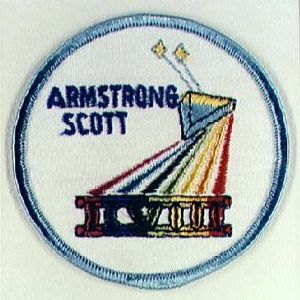 | Gemini 8 Insignia for the Gemini 8 flight Credit: NASA |
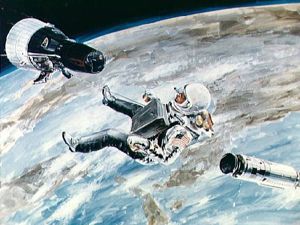 | Gemini 9 Art concept of Astronaut in Manoeuvring Unit Credit: NASA |
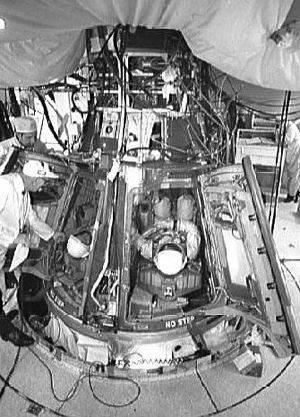 | Gemini 8 Astronauts Scott and Armstrong inserted into Gemini 8 spacecraft Credit: NASA |
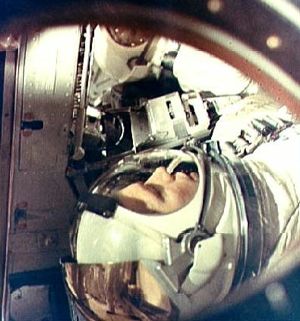 | Gemini 8 Astronaut David R. Scott in Gemini 8 spacecraft during countdown Credit: NASA |
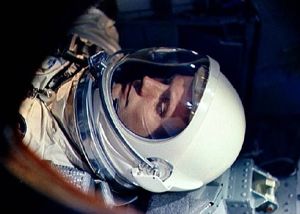 | Gemini 8 Astronaut Neil A. Armstrong in Gemini 8 spacecraft during countdown Credit: NASA |
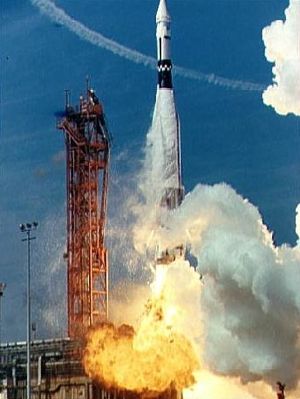 | Gemini 8 Agena Target Docking Vehicle lift-off prior to Gemini 8 launch Credit: NASA |
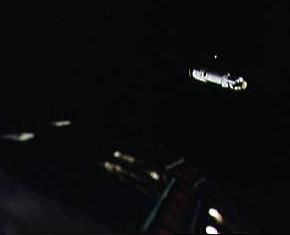 | Gemini 8 Agena Target Docking vehicle seen from Gemini 8 spacecraft Credit: NASA |
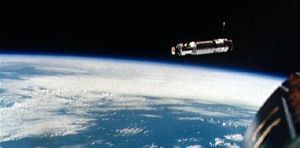 | Gemini 8 Agena Target Docking vehicle seen from Gemini 8 spacecraft Credit: NASA |
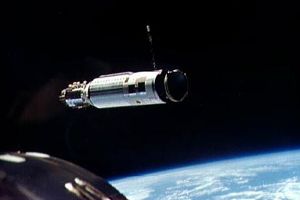 | Gemini 8 Agena Target Docking vehicle seen from Gemini 8 spacecraft Credit: NASA |
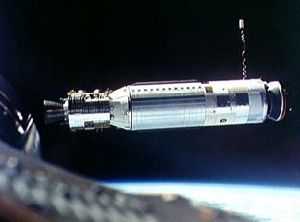 | Gemini 8 Agena Target Docking vehicle seen from Gemini 8 spacecraft Credit: NASA |
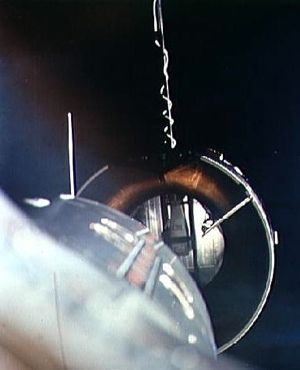 | Gemini 8 Agena Target Docking vehicle seen from Gemini 8 spacecraft Credit: NASA |
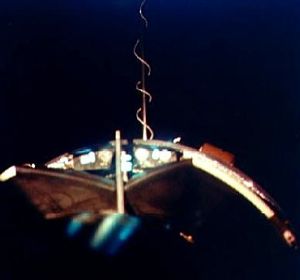 | Gemini 8 Agena Target Docking vehicle seen from Gemini 8 spacecraft Credit: NASA |
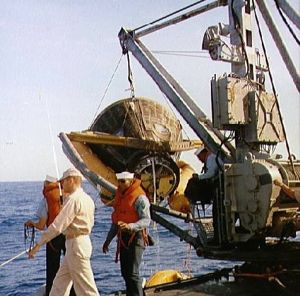 | Gemini 8 Gemini 8 spacecraft hoisted aboard the U.S.S. Leonard F. Mason Credit: NASA |
1964 January - . LV Family: Titan. Launch Vehicle: Titan II.
- The program plan for Gemini extravehicular operations was published. - .
Nation: USA.
Flight: Gemini 10,
Gemini 11,
Gemini 12,
Gemini 5,
Gemini 6,
Gemini 7,
Gemini 8,
Gemini 9.
Spacecraft: Gemini.
Objectives of the operations were to evaluate man's capabilities to perform useful tasks in a space environment, to employ extravehicular operations to augment the basic capability of the spacecraft, and to provide the capability to evaluate advanced extravehicular equipment in support of manned space flight and other national space programs. Additional Details: here....
1964 February 7 - .
- Bernhard A. Hohmann of Aerospace expressed concern at a Gemini Management Panel meeting over spacecraft weight growth. - .
Nation: USA.
Flight: Gemini 8.
Spacecraft: Gemini.
Bernhard A. Hohmann of Aerospace expressed concern at a Gemini Management Panel meeting over spacecraft weight growth. His position was supported by Major General Ben I. Funk of Air Force Space Systems Division, who feared that mounting weight would squeeze out the Department of Defense experiments program. Additional Details: here....
1965 April 15 - . LV Family: Titan. Launch Vehicle: Titan II.
- Martin-Denver delivered the propellant tanks for Gemini launch vehicle 8 to Martin-Baltimore. - .
Nation: USA.
Flight: Gemini 8.
Spacecraft: Gemini.
Tank fabrication had begun September 25, 1964. Aerojet-General delivered the stage I engine on June 16 and the stage II on August 20. In the meantime, tank splicing was completed August 3. Engine installation was completed September 23, and all hoizontal testing ended September 27.
1965 July 23 - . LV Family: Atlas. Launch Vehicle: Atlas SLV-3 Agena D.
- Gemini Agena target vehicle 5003. - .
Nation: USA.
Flight: Gemini 8.
Spacecraft: Gemini Agena Target Vehicle.
Standard Agena D (AD-108), which had been completed in June and held in storage, was transferred to Building 104 at Sunnyvale for modifications and final assembly as Gemini Agena target vehicle 5003. While in storage, several pieces of AD-108 equipment had been removed for modification to the Gemini configuration. Final assembly began August 8.
1965 August 5 - .
- Atlas standard launch vehicle 5302 was shipped from San Diego by truck, arriving at Cape Kennedy August 11. - .
Nation: USA.
Flight: Gemini 8.
Spacecraft: Gemini.
Atlas standard launch vehicle 5302 was shipped from San Diego by truck, arriving at Cape Kennedy August 11. The vehicle had come off the production line and been delivered to the Gemini program on April 2. Final assembly had been completed May 25, installation of flight equipment and Gemini-peculiar kit June 3, and factory testing July 22. Air Force Space Systems Division had formally accepted the vehicle on July 29.
1965 September 20 - .
- McDonnell completed mating the reentry and adapter assemblies of spacecraft No. 8. - . Nation: USA. Flight: Gemini 8. Spacecraft: Gemini. The complete spacecraft was aligned and adjusted. Systems Assurance Tests began September 30..
1965 September 20 - .
- Manned Spacecraft Center announced that Neil A. Armstrong would be command pilot and David R. Scott would be pilot for Gemini VIII. - .
Nation: USA.
Related Persons: Armstrong.
Flight: Gemini 8.
Spacecraft: Gemini.
Manned Spacecraft Center announced that Neil A. Armstrong would be command pilot and David R. Scott would be pilot for Gemini VIII. Backup crew would be Charles Conrad, Jr., and Richard F. Gordon, Jr. Gemini VIII would include practice on rendezvous and docking maneuvers and a space walk that could last as long as one Earth orbit, about 95 minutes.
1965 September 28 - . LV Family: Titan. Launch Vehicle: Titan II.
- Gemini launch vehicle (GLV) 8 in test - .
Nation: USA.
Flight: Gemini 8.
Spacecraft: Gemini.
Gemini launch vehicle (GLV) 8 was erected in the west cell of the vertical test facility at Martin-Baltimore. Power was applied to the vehicle October 13, following the deerection of GLV-7. Subsystems Functional Verification Tests of GLV-8 were completed November 4.
1965 October 14 - . LV Family: Atlas. Launch Vehicle: Atlas SLV-3 Agena D.
- Gemini Agena target vehicle 5003 was transferred to Vehicle Systems Test after completing final assembly on October 9. - . Nation: USA. Flight: Gemini 8. Spacecraft: Gemini Agena Target Vehicle. Gemini Agena target vehicle 5003 was transferred to Vehicle Systems Test after completing final assembly on October 9. Testing began October 18..
1965 October 22 - .
- McDonnell completed Systems Assurance Tests of spacecraft No. 8 and validation of the spacecraft environmental control system. - . Nation: USA. Flight: Gemini 8. Spacecraft: Gemini. McDonnell completed Systems Assurance Tests of spacecraft No. 8 and validation of the spacecraft environmental control system. The spacecraft simulated flight was conducted October 26-November 4..
1965 November 8 - . LV Family: Titan. Launch Vehicle: Titan II.
- Acceptance Test of Gemini launch vehicle (GLV) 8 - .
Nation: USA.
Flight: Gemini 8.
Spacecraft: Gemini.
The Combined Systems Acceptance Test of Gemini launch vehicle (GLV) 8 was conducted at Martin-Baltimore. The vehicle acceptance team convened November 16 and completed its inspection November 19, deeming the vehicle excellent. GLV-8 was deerected December 13-14 and was formally accepted by the Air Force on December 23. Stage I was airlifted to Cape Kennedy on January 4, 1966, followed by stage II on January 6. Both stages were placed in storage.
1965 November 24 - . LV Family: Atlas. Launch Vehicle: Atlas SLV-3 Agena D.
- Lockheed submitted an engineering change proposal to Air Force Space Systems Division (SSD) for Project Surefire. - .
Nation: USA.
Flight: Gemini 8,
Gemini 9.
Spacecraft: Gemini Agena Target Vehicle.
Lockheed submitted an engineering change proposal to Air Force Space Systems Division (SSD) for Project Surefire. Surefire was the code name for the Gemini Agena Target Vehicle (GATV) Modification and Test Program designed to correct the malfunction which had caused the failure of GATV 5002 on October 25. Additional Details: here....
1965 November 26 - . LV Family: Atlas. Launch Vehicle: Atlas SLV-3 Agena D.
- McDonnell proposed building a backup target vehicle for Gemini rendezvous missions. - .
Nation: USA.
Flight: Gemini 8.
Spacecraft: Gemini,
Gemini Radar,
Atlas Target Docking Adapter.
The augmented target docking adapter (ATDA) would serve as an alternative to the Gemini Agena target vehicle (GATV) if efforts to remedy the GATV problem responsible for the October 25 mission abort did not meet the date scheduled for launching Gemini VIII. Additional Details: here....
1965 December 3 - .
- McDonnell began altitude chamber and extravehicular support package tests of spacecraft No. 8. - . Nation: USA. Flight: Gemini 8. Spacecraft: Gemini. These tests were completed December 13. During the remainder of the month, the spacecraft was updated and retested before being shipped to Cape Kennedy on January 8, 1966..
1965 December 17 - . LV Family: Atlas. Launch Vehicle: Atlas SLV-3 Agena D.
- Gemini Agena target vehicle (GATV) 5003 main engine - .
Nation: USA.
Flight: Gemini 8.
Spacecraft: Gemini Agena Target Vehicle.
The Air Force accepted the main rocket engine for Gemini Agena target vehicle (GATV) 5003 after Bell Aerosystems had completed Project Surefire modifications. The engine was shipped immediately and arrived at Lockheed December 18. Lockheed completed reinstalling the engine on December 20. GATV 5003 systems retesting began December 27 after other equipment modifications had been installed.
1966 January 5 - . Launch Vehicle: Atlas SLV-3 Agena D.
- Atlas 5302 erected at complex 14. - .
Nation: USA.
Flight: Gemini 8.
Spacecraft: Gemini.
Atlas 5302, target launch vehicle for Gemini VIII, was erected at complex 14. Air Force Space Systems Division and General Dynamics/Convair had begun intensive efforts to ensure the vehicle's flight readiness immediately after the Agena failure on October 25, 1965. Additional Details: here....
1966 January 6 - .
- No sign of Soviets catching up in space - .
Nation: Russia.
Program: Voskhod.
Flight: Gemini 10,
Gemini 11,
Gemini 8,
Soyuz 1,
Soyuz 2A,
Voskhod 3,
Voskhod 4.
Spacecraft: Soyuz 7K-OK,
Voskhod,
Gemini.
Kamanin reviews the American and Soviet space plans as known to him. In 1965 the Americans flew five manned Gemini missions, and the Soviets, a single Voskhod. In 1966, the Americans plan to accomplish the first space docking with Gemini 8, demonstrate a first-orbit rendezvous and docking with Gemini 10, demonstrate powered flight using a docked Agena booster stage with Gemini 11, and rendezvous with an enormous Pegasus satellite. Against this, the Soviets have no program, no flight schedule. Kamanin can only hope that during the year 2-3 Voskhod flights and 2-3 Soyuz flights may be conducted.
1966 January 8 - .
- McDonnell delivered spacecraft No. 8 to Cape Kennedy. - .
Nation: USA.
Flight: Gemini 8.
Spacecraft: Gemini.
Fuel cell installation, heater resistance checks, and pyrotechnics buildup lasted two weeks. The spacecraft was then transferred to Merritt Island Launch Area for integrated (Plan X) test with the target vehicle, January 26-28, and extravehicular equipment compatibility test, January 29.
1966 January 8 - . LV Family: Atlas. Launch Vehicle: Atlas SLV-3 Agena D.
- Gemini Agena target vehicle (GATV) 5003 completed its final acceptance tests. - .
Nation: USA.
Flight: Gemini 8.
Spacecraft: Gemini Agena Target Vehicle.
Gemini Agena target vehicle (GATV) 5003 completed its final acceptance tests at Sunnyvale, after an elusive command system problem had made it necessary to rerun the final systems test (January 4). No vehicle discrepancy marred the rerun. Air Force Space Systems Division formally accepted GATV 5003 on January 18, after the vehicle acceptance team inspection. It was shipped to Eastern Test Range the same day, but bad weather delayed delivery until January 21. GATV 5003 was to be the target vehicle for Gemini VIII.
1966 January 13 - . LV Family: Titan. Launch Vehicle: Titan II.
- Gemini launch vehicle (GLV) 8 was erected at complex 19. - . Nation: USA. Flight: Gemini 8. Spacecraft: Gemini. After the vehicle was inspected and umbilicals connected, power was applied January 19. Subsystems Reverification Tests began the following day and lasted until January 31. . Additional Details: here....
1966 January 16 - . LV Family: Atlas. Launch Vehicle: Atlas SLV-3 Agena D.
- Project Surefire verification testing began at Bell Aerosystems. - .
Nation: USA.
Flight: Gemini 8.
Spacecraft: Gemini Agena Target Vehicle.
Bell's part in the test program was to demonstrate the sea-level flightworthiness of the modified Agena main engine. Bell completed testing on March 4 with a full 180-second mission simulation firing. The successful completion of this phase of the test program gave the green light for the launch of Gemini Agena target vehicle 5003, scheduled for March 15.
1966 January 17 - . LV Family: Atlas. Launch Vehicle: Atlas SLV-3 Agena D.
- Gemini Program Office review of possible future mission activities. - .
Nation: USA.
Flight: Gemini 10,
Gemini 8,
Gemini 9.
Spacecraft: Gemini.
At a NASA-McDonnell Management Panel meeting, W. B. Evans of Gemini Program Office reviewed possible future mission activities. Gemini VIII would have three periods of extravehicular activity (EVA) - two in daylight, one in darkness - and would undock during EVA with the right hatch snubbed against the umbilical guide and the astronaut strapped into the adapter section. Additional Details: here....
1966 January 21 - .
- Qualification testing of the freon-14 extravehicular propulsion system for the Gemini VIII mission had been successfully completed. - .
Nation: USA.
Flight: Gemini 8.
Spacecraft: Gemini.
Qualification testing of the freon-14 extravehicular propulsion system for the Gemini VIII mission had been successfully completed. During earlier tests some freezing problems had resulted; however, with particular attention given to drying procedures used in loading the gas, the freezing problem was eliminated, and later tests were successful. Oxygen had been used for propulsion fuel during extravehicular activities by Astronaut Edward H. White II on Gemini IV.
1966 January 22 - . LV Family: Atlas. Launch Vehicle: Atlas SLV-3 Agena D.
- Gemini Agena target vehicle (GATV) 5003 was mated to target docking adapter (TDA) 3. - .
Nation: USA.
Flight: Gemini 8.
Spacecraft: Gemini Agena Target Vehicle.
McDonnell had delivered TDA-3 to Cape Kennedy on January 8. The GATV/TDA interface functional test was completed January 24, and the vehicle was transferred to Merritt Island Launch Area for integrated tests with spacecraft No. 8 and extravehicular equipment, which were completed January 28.
1966 January 28 - . LV Family: Atlas. Launch Vehicle: Atlas SLV-3 Agena D.
- Gemini Agena target vehicle (GATV) 5003 was returned to Hanger E after completing Plan X tests at Merritt Island Launch Area. - .
Nation: USA.
Flight: Gemini 8.
Spacecraft: Gemini Agena Target Vehicle.
Gemini Agena target vehicle (GATV) 5003 was returned to Hanger E after completing Plan X tests at Merritt Island Launch Area. Systems Verification and Combined Interface Tests were conducted through February 18, followed by functional checks of the primary and secondary propulsion systems. Hanger E testing ended February 28, and the GATV was transferred to complex 14.
1966 January 31 - .
- Gemini spacecraft No. 8 was transferred to complex 19 and hoisted to its position atop the launch vehicle. - .
Nation: USA.
Flight: Gemini 8.
Spacecraft: Gemini.
Gemini spacecraft No. 8 was transferred to complex 19 and hoisted to its position atop the launch vehicle. Cables were connected for test February 1-2, and Prespacecraft Mate Verification Tests were conducted February 3-8. Fuel cells were activated February 8 and deactivated the following day. Spacecraft / launch vehicle integrated tests began February 10.
1966 February 10 - . LV Family: Titan. Launch Vehicle: Titan II.
- Gemini launch vehicle 8 and spacecraft 8 were electrically mated. - . Nation: USA. Flight: Gemini 8. Spacecraft: Gemini. The Electrical Interface Integrated Validation and Joint Guidance and Control Test was completed February 14. After data from this test were reviewed (February 15), the Joint Combined Systems Test was run February 16..
1966 February 17 - . LV Family: Titan. Launch Vehicle: Titan II.
- The tanking test of Gemini launch vehicle (GLV) 8 was conducted. - .
Nation: USA.
Flight: Gemini 8.
Spacecraft: Gemini.
While the launch vehicle was being cleaned up after the test, spacecraft No. 8 Final Systems Test was completed February 23. On February 25, GLV and spacecraft were temporarily mated for an erector-cycling test. The extravehicular support package and life support system were checked out and installed in the spacecraft between February 26 and March 5, while GLV systems were modified and revalidated February 28 to March 3.
1966 February 23 - .
- A successful Booster Flight Acceptance Composite Test (B-FACT) completed subsystems testing of target launch vehicle 5302. - .
Nation: USA.
Flight: Gemini 8.
Spacecraft: Gemini.
A successful Booster Flight Acceptance Composite Test (B-FACT) completed subsystems testing of target launch vehicle 5302. Component problems had delayed completion of some of the vehicle pad tests, including B-FACT, which had first been run on February 4. Difficulties were also encountered in completing the propellant tanking tests.
1966 March 1 - . Launch Vehicle: Atlas SLV-3 Agena D.
- Gemini Agena target vehicle 5003 was mated to targate launch vehicle 5302 at complex 14. - .
Nation: USA.
Flight: Gemini 8.
Spacecraft: Gemini Agena Target Vehicle.
After ground equipment compatibility tests, the Joint Flight Acceptance Composite Test was successfully performed on March 7. Simultaneous Launch Demonstration March 8-9 completed Gemini Atlas-Agena target vehicle systems testing in preparation for launch on March 15 as part of the Gemini VIII mission.
1966 March 6 - . Launch Vehicle: Atlas SLV-3 Agena D.
- Gemini launch vehicle 8 and spacecraft No. 8 were mated for flight at complex 19. - . Nation: USA. Flight: Gemini 8. Spacecraft: Gemini Agena Target Vehicle. The Simultaneous Launch Demonstration with the Gemini Atlas-Agena target vehicle on complex 14 was completed March 9. The Final Simulated Flight Test concluded prelaunch tests on March 10..
1966 March 13 - .
- The fuel tank of target launch vehicle 5302 was overfilled during propellant loading. - . Nation: USA. Flight: Gemini 8. Spacecraft: Gemini. The necessary replacement of the fuel-tank regulator and fuel relief valve was completed the next day. The launch, which had been scheduled for March 15, was postponed to March 16..
1966 March 16 - . LV Family: Atlas. Launch Vehicle: Atlas SLV-3 Agena D.
- Gemini Agena target vehicle 5003 systems exercised. - .
Nation: USA.
Flight: Gemini 10,
Gemini 8.
Spacecraft: Gemini Agena Target Vehicle.
Following the early termination of Gemini VIII, Gemini Agena target vehicle (GATV) 5003 remained in orbit, where its various systems were extensively exercised. The main engine was fired nine times, four more than required by contract, and 5000 commands were received and executed by the command and communications system, as against a contractural requirement of 1000. Additional Details: here....
1966 March 16 - . 15:00 GMT - . Launch Site: Cape Canaveral. Launch Complex: Cape Canaveral LC14. LV Family: Atlas. Launch Vehicle: Atlas SLV-3 Agena D.
- Gemini 8 Agena Target - . Payload: TDA 3/Agena D 5003 GATV. Mass: 3,175 kg (6,999 lb). Nation: USA. Agency: NASA Houston. Class: Manned. Type: Manned logistics spacecraft. Flight: Gemini 8. Spacecraft Bus: Agena. Spacecraft: Gemini Agena Target Vehicle. Decay Date: 1967-09-15 . USAF Sat Cat: 2104 . COSPAR: 1966-019A. Apogee: 299 km (185 mi). Perigee: 285 km (177 mi). Inclination: 28.90 deg. Period: 90.40 min. Target vehicle for Gemini 8..
1966 March 16 - . 16:41 GMT - . Launch Site: Cape Canaveral. Launch Complex: Cape Canaveral LC19. LV Family: Titan. Launch Vehicle: Titan II GLV.
- Gemini 8 - .
Call Sign: Gemini 8. Crew: Armstrong,
Scott.
Backup Crew: Conrad,
Gordon.
Payload: Gemini SC8. Mass: 3,788 kg (8,351 lb). Nation: USA.
Agency: NASA Houston.
Class: Manned.
Type: Manned spacecraft. Flight: Gemini 8.
Spacecraft: Gemini.
Duration: 0.45 days. Decay Date: 1966-03-17 . USAF Sat Cat: 2105 . COSPAR: 1966-020A. Apogee: 264 km (164 mi). Perigee: 160 km (90 mi). Inclination: 28.90 deg. Period: 88.80 min.
The Atlas-Agena target vehicle for the Gemini VIII mission was successfully launched from KSC Launch Complex 14 at 10 a.m. EST March 16. The Gemini VIII spacecraft followed from Launch Complex 19 at 11:41 a.m., with command pilot Neil A. Armstrong and pilot David R. Scott aboard. The spacecraft and its target vehicle rendezvoused and docked, with docking confirmed 6 hours 33 minutes after the spacecraft was launched. This first successful docking with an Agena target vehicle was followed by a major space emergency. About 27 minutes later the spacecraft-Agena combination encountered unexpected roll and yaw motion. A stuck thruster on Gemini put the docked assembly into a wild high speed gyration. Near structural limits and blackout, Armstrong undocked, figuring the problem was in the Agena, which only made it worse. The problem arose again and when the yaw and roll rates became too high the crew shut the main Gemini reaction control system down and activated and used both rings of the reentry control system to reduce the spacecraft rates to zero. This used 75% of that system's fuel. Although the crew wanted to press on with the mission and Scott's planned space walk, ground control ordered an emergency splashdown in the western Pacific during the seventh revolution. The spacecraft landed at 10:23 p.m. EST March 16 and Armstrong and Scott were picked up by the destroyer U.S.S. Mason at 1:37 a.m. EST March 17. Although the flight was cut short by the incident, one of the primary objectives - rendezvous and docking (the first rendezvous of two spacecraft in orbital flight) - was accomplished.
Primary objectives of the scheduled three-day mission were to rendezvous and dock with the Gemini Agena target vehicle (GATV) and to conduct extravehicular activities. Secondary objectives included rendezvous and docking during the fourth revolution, performing docked maneuvers using the GATV primary propulsion system, executing 10 experiments, conducting docking practice, performing a rerendezvous, evaluating the auxiliary tape memory unit, demonstrating controlled reentry, and parking the GATV in a 220-nautical mile circular orbit. The GATV was inserted into a nominal 161-nautical mile circular orbit, the spacecraft into a nominal 86 by 147-nautical mile elliptical orbit. During the six hours following insertion, the spacecraft completed nine maneuvers to rendezvous with the GATV. Rendezvous phase ended at 5 hours 58 minutes ground elapsed time, with the spacecraft 150 feet from the GATV and no relative motion between the two vehicles. Stationkeeping maneuvers preceded docking, which was accomplished at 6 hours 33 minutes ground elapsed time. A major problem developed 27 minutes after docking, when a spacecraft orbit attitude and maneuver system (OAMS) thruster malfunctioned. The crew undocked from the GATV and managed to bring the spacecraft under control by deactivating the OAMS and using the reentry control system (RCS) to reduce the spacecraft's rapid rotation. Premature use of the RCS, however, required the mission to be terminated early. The retrofire sequence was initiated in the seventh revolution, followed by nominal reentry and landing in a secondary recovery area in the western Pacific Ocean. The spacecraft touched down less than 10 km from the planned landing point. The recovery ship, the destroyer Leonard Mason, picked up both crew and spacecraft some three hours later. Early termination of the mission precluded achieving all mission objectives, but one primary objective - rendezvous and docking - was accomplished. Several secondary objectives were also achieved: rendezvous and docking during the fourth revolution, evaluating the auxiliary tape memory unit, demonstrating controlled reentry, and parking the GATV. Two experiments were partially performed.
1966 March 24 - . LV Family: Atlas. Launch Vehicle: Atlas SLV-3 Agena D.
- Project Surefire test program not to be curtailed. - . Nation: USA. Flight: Gemini 8. Spacecraft: Gemini Agena Target Vehicle. Air Force Space Systems Division and Lockheed agreed not to curtail the Project Surefire test program despite the excellent performance of Gemini Agena target vehicle (GATV) 5003 during the Gemini VIII mission. . Additional Details: here....
1966 June 19 - . LV Family: Atlas. Launch Vehicle: Atlas SLV-3 Agena D.
- Gemini X prime crew to be Young and Collins. - .
Nation: USA.
Flight: Gemini 10,
Gemini 8.
Spacecraft: Gemini Agena Target Vehicle.
NASA announced that the Gemini X mission had been scheduled for no earlier than July 18, with John W. Young, command pilot, and Michael Collins, pilot, as the prime crew. Alan L. Bean, command pilot, and Clifton C. Williams, pilot, would be the backup crew. Mission plans would include rendezvous, docking, and extravehicular activity. The spacecraft was scheduled to rendezvous and dock with an Agena target vehicle which was to be launched the same day. If possible, Gemini X would also rendezvous with the Agena launched in the March 16 Gemini VIII mission.
1966 July 18 - . LV Family: Atlas. Launch Vehicle: Atlas SLV-3 Agena D.
- Gemini Agena target vehicle (GATV) 5006 was mated to target docking adapter (TDA) 6. - . Nation: USA. Flight: Gemini 10, Gemini 11, Gemini 8. Spacecraft: Gemini Agena Target Vehicle. McDonnell had delivered TDA-6 to Cape Kennedy July 7. The interface functional test was completed July 21. The next day GATV 5006 was moved to the Merritt Island Launch Area for integrated tests with spacecraft No. 11 and extravehicular equipment..
Back to top of page
Home - Search - Browse - Alphabetic Index: 0- 1- 2- 3- 4- 5- 6- 7- 8- 9
A- B- C- D- E- F- G- H- I- J- K- L- M- N- O- P- Q- R- S- T- U- V- W- X- Y- Z
© 1997-2019 Mark Wade - Contact
© / Conditions for Use